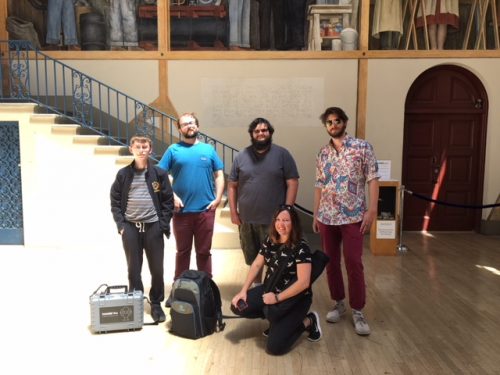
When Boise State’s Center for Fine Arts opens in 2019, one of its top attractions will be the interactive, high-tech World Museum, a sleek public space on the building’s ground floor. The museum will use virtual reality technology to let visitors “see” works of art in museums thousands of miles from Boise. A group from Boise State recently spent a week in California working to build the World Museum’s digital collection.
Fonda Portales, manager of the university’s art collection and World Museum curator, as well as Steve Cutchin from the Department of Computer Science, Karen Doty from Games, Interactive Media and Mobile, and four students from those departments, traveled to Los Angeles on June 17 armed with a collection of cameras and video equipment. They worked with staff at California State University Los Angeles to digitize artifacts from the CSULA collections for the World Museum, including scholarly texts on Mesoamerica and facsimiles of image-rich Aztec texts.
“The collections share the heart of the historical memory of Mexico with the people of the United States. We hope that many students, teachers, researchers and people of all trades of life will use these books,” said Manuel Aguilar-Moreno, a professor of art history at CSULA. The digitized materials will be available to scholars at CSULA as well as Boise State, helping build a partnership between the universities. The project is a “pioneering and cutting edge undertaking,” said Aguilar-Moreno.
“It will set the example for other institutions to utilize new technologies in creative ways that, in addition to establishing ties between our academic institutions, will contribute to strengthening the understanding of other cultures,” he said.
Digitizing texts — some of which are more than a century old and fragile — will also help preserve them. The process will allow for the addition of interpretive material to enhance the digital texts, Portales said. That could include images, commentary, animations and more.
After Los Angeles, the Boise State students and faculty traveled to San Francisco. They spent time at the San Francisco Art Institute photographing high-resolution panoramas to create a 3D version of The Making of a Fresco Showing the Building of a City, a mural painted on site in 1931 by Mexican artist Diego Rivera.
The crew also photographed public art in Santa Monica, Beverly Hills, Downtown Los Angeles and in San Francisco, including a mural on the exterior of The Women’s Building in the Mission District. The mural features images of Guanyin, the East Asian goddess of mercy and compassion, Hanan Ashrawi, the Palestinian scholar and legislator, Georgia O’Keefe, the American painter, and many others.
The photographic process to create virtual reality experiences is intense. It requires several hours to photograph a single work — capturing it from all angles, from underneath, from above, and even from across the street in the case of outside, public art. GIMM students also shot video, so the university will have images in many formats, said Portales.
Portales hopes to build Boise State’s digital art collection from more site visits like the visit to California, depending on schedules and funding. Images will also come from museums that have made their collections available to the public. That includes institutions like the Rijksmuseum in Amsterdam, home to 250,000 pieces, including masterpieces by Rembrandt, Vermeer, and Van Gogh.
Portales wants to make the World Museum art collection as diverse as possible by including pieces from many cultures and traditions. Photographing the Mesoamerican texts and the Rivera mural represents a step in that direction — a nod to the long history of Latino art, and to the growing Latino community in the Treasure Valley.
“We want to show works that people can relate to,” said Portales.
The World Museum isn’t intended as a substitute for seeing art in real spaces, she added. Rather, she hopes the museum and its growing collection will inspire more cultural curiosity in the Boise State community.